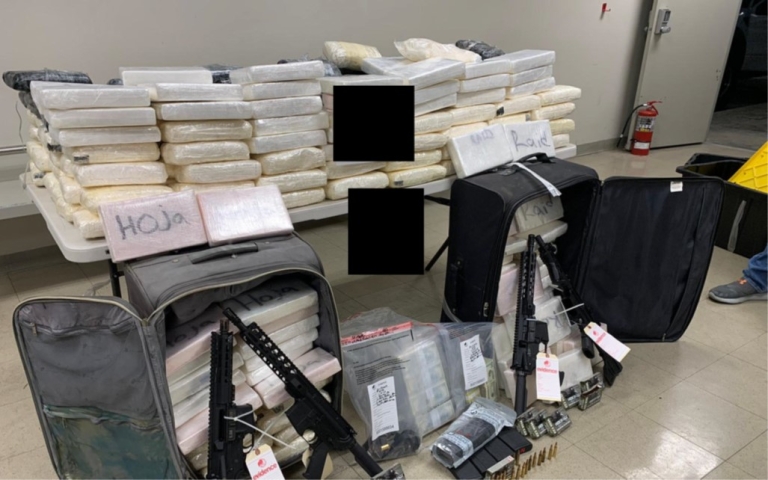Dairo Antonio Úsuga David, aka Otoniel, Also Ordered to Pay $216 Million in Forfeiture
In federal court today, a citizen of Colombia was sentenced to 45 years in prison for engaging in a continuing criminal enterprise as a leader of the multibillion-dollar paramilitary and drug trafficking organization known as the “Clan del Golfo” (CDG).
According to court documents, Dairo Antonio Úsuga David, aka Otoniel, 51, of Antioquia, Colombia, was also sentenced to 45 years in prison for engaging in a maritime narcotics conspiracy and 45 years in prison for engaging in a narcotics importation conspiracy. The sentences will run concurrently. As part of the sentence, the court ordered Úsuga David to pay $216 million in forfeiture. The defendant pleaded guilty to all three charges in January 2023.
“Otoniel led one of the largest cocaine trafficking organizations in the world, where he directed the exportation of massive amounts of cocaine to the United States and ordered the ruthless execution of Colombian law enforcement, military officials, and civilians,” said Attorney General Merrick B. Garland. “This sentence sends a clear message: the Justice Department will find and hold accountable the leaders of deadly drug trafficking organizations that harm the American people, no matter where they are and no matter how long it takes.”
“Today’s sentencing demonstrates DEA’s commitment to defeating deadly criminal networks who have no regard for human life,” said Drug Enforcement Administration (DEA) Administrator Anne Milgram. “DEA investigated Otoniel – one of the most violent and prolific drug traffickers in the world – for almost 20 years. Under Otoniel’s leadership, the Clan del Golfo shipped massive quantities of cocaine into the United States, terrorized the Colombian people, and killed civilians, law enforcement officers, and rivals in Colombia who threatened the organization’s trafficking operations. I commend the men and women of the DEA for their many years of outstanding work that culminated in today’s sentencing.”
“The human misery caused by the defendant’s incredibly violent, vengeful, and bloody reign as leader of the Clan del Golfo drug trafficking organization may never be fully calculated due to its magnitude, but today’s lengthy sentence delivers appropriate justice and sends a message to other paramilitary and cartel leaders that the United States will seek their arrest and extradition in order to hold them accountable in our courts of law,” said U.S. Attorney Breon Peace for the Eastern District of New York.
“Today’s 45-year sentence of Clan del Golfo’s notoriously violent leader illustrates the United States’ tenacious approach to securing justice against those who threaten the security of our nation and communities,” said U.S. Attorney for the Southern District of Florida Markenzy Lapointe. “Cartel leaders like Úsuga David will be found, extradited, and prosecuted.”
“Today’s sentencing of notorious Clan del Golfo leader Dairo Antonio Úsuga David is the culmination of years of collaborative efforts between HSI and our local, federal and international law enforcement partners,” said Special Agent in Charge Ivan J. Arvelo of Homeland Security Investigations (HSI) New York. “Criminals should take note of this sentencing and heed its warning; HSI remains committed to these joint efforts to disrupt and dismantle criminal organizations whose illicit activities threaten the national security of the United States and the safety of our communities.”
Between June 2003 and October 2021, Úsuga David was the leader of a continuing criminal enterprise responsible for exporting multi-ton shipments of cocaine from Colombia to Mexico and Central America for ultimate importation into the United States. Additionally, Úsuga David participated in conspiracies to distribute narcotics via maritime vessels and also to manufacture and distribute cocaine, knowing and intending that the narcotics would be illegally imported into the United States.
The Clan Del Golfo
The CDG is one of the most violent and powerful criminal organizations in Colombia, and it is one of the largest distributors of cocaine in the world. With as many as 6,000 members at times, the CDG exercises military control over vast amounts of territory in the Urabá region of Antioquia, Colombia, one of the most lucrative drug trafficking areas within Colombia due to its proximity to the Colombia-Panama border and the Caribbean and Pacific coasts. Clad in military uniforms, CDG members employ military tactics and weapons to reinforce their power and incite wars and violence against rival drug traffickers, paramilitary organizations, and Colombian law enforcement authorities who threaten the CDG’s control.
The CDG funds its operations primarily through a multi-billion-dollar drug trafficking operation. It imposes a “tax” on any drug traffickers operating in territory under its control, charging fees for every kilogram of cocaine manufactured, stored, or transported through areas controlled by the organization. The CDG also directly exports cocaine and coordinates the production, purchase, and transfer of weekly and bi-weekly multi-ton shipments of cocaine from Colombia into Central America and Mexico for ultimate importation to the United States.
To maintain control over CDG territory, Úsuga David and the CDG employed an army of “sicarios,” or hitmen, who carried out acts of violence, including murders, assaults, kidnappings, torture, and assassinations against competitors and those deemed traitors to the organization, as well as their family members. The CDG murdered and assaulted Colombian law enforcement officers, Colombian military personnel, rival drug traffickers and paramilitaries, potential witnesses, and civilians. Úsuga David and the CDG used violence to promote and enhance the reputation and position of the CDG with respect to rival criminal organizations; preserve, protect, and expand the CDG’s power and territory; finance the CDG’s operations and enrich its leaders through the collection of drug debts; maintain discipline among its members and associates; and protect CDG members from arrest and prosecution by attempting to silence potential witnesses and retaliating against law enforcement authorities and those assisting law enforcement.
Úsuga David served as a high-ranking leader within the CDG from its inception and was its principal leader for approximately 10 years. During his reign, Úsuga David oversaw all of the CDG’s activities and directed its members to engage in extensive criminal acts, including acts of violence, mandated shutdowns of all business activities and civilian movement within designated regions of Colombia, retaliation against law enforcement authorities and potential witnesses, the exertion of control over drug manufacturing facilities and trafficking routes, and the exportation of cocaine in multi-ton quantities.
Úsuga David assumed power and territorial control over vast swaths of the Colombian coastline and personally directed members of the CDG to commit acts of violence to reinforce that power. This included violence against civilians. For example, in early 2012, following the death of Úsuga David’s brother in a police raid, Úsuga David ordered a multi-day shutdown be imposed on towns and communities within the CDG’s control. During the strike, CDG members ordered that all businesses remain closed, and that residents stay in their homes. Úsuga David ordered CDG members to execute those who did not adhere to his orders.
Úsuga David also personally ordered CDG members to commit murders of specific individuals, including the murders of rival drug traffickers and members of the CDG who betrayed him or the organization. For example, Úsuga David ordered the assassinations of multiple individuals who worked for a rival drug trafficking organization.
In addition, Úsuga David regularly directed CDG members to use violence, intimidation, and murder to dissuade law enforcement authorities from performing their duties and to silence potential witnesses. For example, at Úsuga David’s direction, the CDG carried out organized campaigns, referred to as “Plan Pistolas,” to kill Colombian law enforcement and military personnel using military-grade weapons, including grenades, explosives, and assault rifles. Úsuga David offered bounties for the murder of Colombian police officers and military personnel to intimidate law enforcement authorities and prevent them from capturing him or interfering in the CDG’s business. Úsuga David’s organization made numerous attempts to assassinate individuals who were believed to be cooperating with law enforcement.
Úsuga David was also extensively involved in the narcotics activities that funded the CDG and enabled its power. He oversaw the CDG’s drug trafficking exports and directed a network of “debt collectors” tasked with the enforcement and collection of taxes paid by drug trafficking organizations that operated in regions controlled by the CDG. In addition, Úsuga David controlled cocaine manufacturing facilities and used the CDG’s extensive distribution network to export cocaine independently for his own personal profit.
As part of the sentence, the court ordered Úsuga David to pay a $216 million forfeiture money judgment. The forfeiture money judgment is subject to the agreement between the U.S. government and the Government of the Republic of Colombia concerning the sharing of forfeited proceeds and instrumentalities of crime.
The DEA, HSI, FBI, New York City Police Department (NYPD), and New York State Police (NYSP) investigated the case. The United States Attorneys’ Offices for the Middle District of Florida and Eastern District of Texas, the Justice Department’s Office of International Affairs, the Criminal Division’s Narcotic and Dangerous Drug Section (NDDS), Judicial Attachés in Bogotá, Colombia, and attorneys assigned at the Special Operations Division, the U.S. Marshals Service, the Port Authority Police Department, the Colombian Attorney General’s Office, the Colombian National Police, the Colombian Ministry of National Defense, the Colombian Ministry of Justice, and the Colombian Ministry of Foreign Affairs provided valuable assistance in the investigation, arrest, and extradition of the defendant.
Assistant U.S. Attorneys Francisco J. Navarro, Gillian Kassner, and Tara B. McGrath for the Eastern District of New York prosecuted the case. Assistant U.S. Attorney Claire S. Kedeshian for the Eastern District of New York is handling forfeiture matters. Assistant U.S. Attorneys Robert Emery for the Southern District of Florida and Alexander Li for the Southern District of New York led the prosecutions for their respective offices.
The investigation, extradition, and conviction of Úsuga David is part of an Organized Crime Drug Enforcement Task Forces (OCDETF) investigation. OCDETF identifies, disrupts, and dismantles the highest-level drug traffickers, money launderers, gangs, and transnational criminal organizations that threaten the United States by using a prosecutor-led, intelligence-driven, multi-agency approach that leverages the strengths of federal, state, and local law enforcement agencies against criminal networks.













